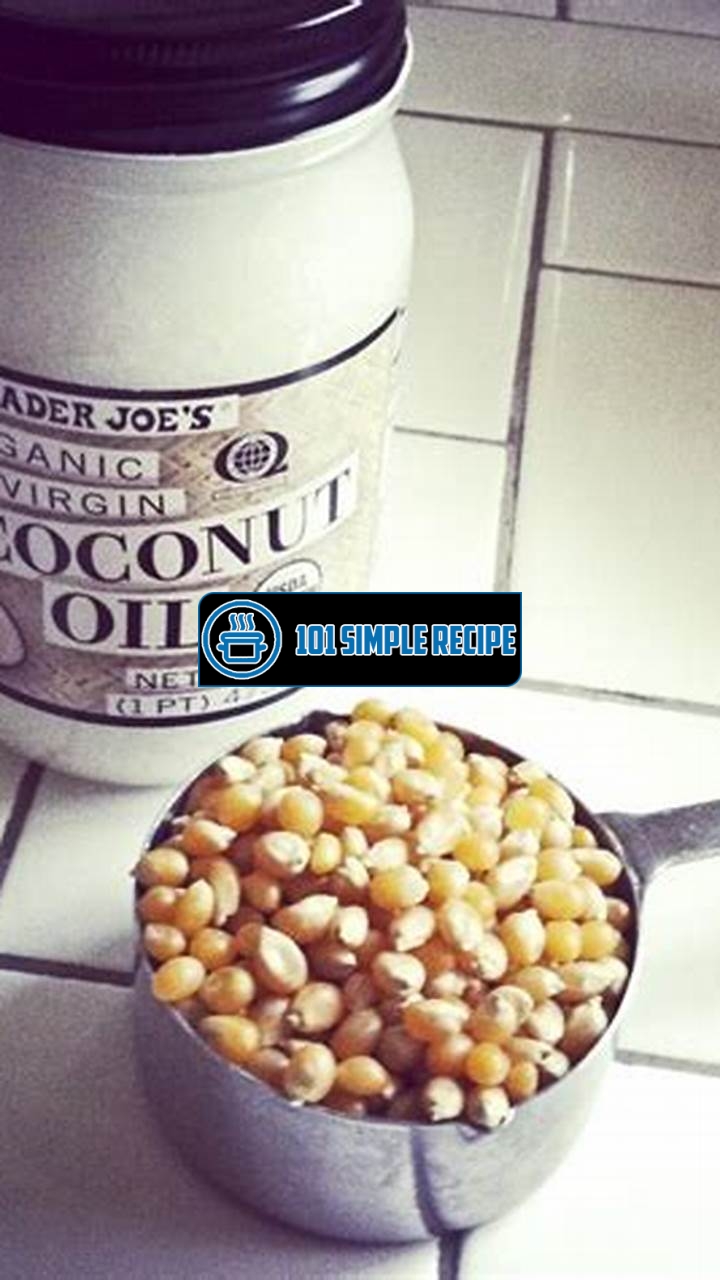Are you craving a delicious bowl of homemade popcorn? Look no further! Making popcorn on the stove with vegetable oil is the perfect way to satisfy your snack cravings. This classic method is not only quick and easy, but it also allows you to control the flavor and seasoning of your popcorn. By using vegetable oil, you can achieve a light and crispy texture that is simply irresistible. In this article, we will guide you through the step-by-step process of making the perfect stove-popped popcorn with vegetable oil. So grab a bag of kernels and get ready to enjoy a tasty treat!

The Science Behind Popping Corn
Discover the fascinating science behind popcorn popping and how it works.
How Popcorn Pops
Have you ever wondered how popcorn pops? It’s a fascinating process that involves a little science and a lot of heat. When popcorn kernels are heated, the moisture inside them turns into steam. As the steam builds up, it creates pressure inside the kernel. Eventually, the pressure becomes so great that it bursts the hard outer shell and turns the kernel inside out. This rapid expansion and release of steam are what make popcorn pop.
✨
When you place popcorn kernels on the stove with vegetable oil and heat them up, the oil serves as a conductor of heat. Through conduction, the heat is transferred from the stove to the kernels, causing them to pop. Once the popping starts, the steam that’s released carries the popcorn upwards, allowing it to escape from the pot or pan and become fluffy, delicious popcorn.
The Role of Kernel Moisture
The moisture content of popcorn kernels plays a crucial role in the popping process. Popcorn kernels typically contain about 14-15% moisture. This moisture allows the kernels to pop when exposed to heat. Without enough moisture, the kernels won’t have the necessary steam pressure to burst open and turn into fluffy popcorn. On the other hand, if the kernels have too much moisture, they may not pop properly and instead become chewy or burnt.
So, how do you know if your popcorn kernels have the right moisture content? One way is to feel the kernels. If they feel dry and brittle, they may not have enough moisture to pop properly. On the other hand, if they feel soft or damp, they may have too much moisture. It’s also important to store your popcorn kernels in an airtight container to maintain their moisture level.
Heat Transfer during Popping
During the popping process, heat transfer is essential to turn the kernels into popcorn. As mentioned earlier, the vegetable oil acts as a conductor of heat, allowing the kernels to absorb the heat from the stove. The heat causes the moisture inside the kernels to turn into steam and build up pressure, leading to the eventual pop.
️
Heat is transferred from the stove to the pot or pan and then to the popcorn kernels. It’s important to distribute the heat evenly to ensure that all the kernels pop at the same time. If there are any hotspots in the pot or pan, some kernels may pop sooner or later than others. To achieve uniform popping, it’s recommended to shake the pot or pan occasionally to distribute the heat more evenly.
In conclusion, making popcorn on the stove with vegetable oil involves some fascinating science. Understanding the process behind popcorn popping, the role of kernel moisture, and heat transfer can help you achieve perfect, fluffy popcorn every time. So, grab your favorite pot or pan, some popcorn kernels, and vegetable oil, and enjoy the science-filled experience of making homemade popcorn.
Choosing the Right Oil
When it comes to making stovetop popcorn, choosing the right oil is essential for a delicious and flavorful snack. While there are various oils available, vegetable oil is often the go-to option for many popcorn enthusiasts. However, not all vegetable oils are created equal, and it’s important to select the best one for your popcorn-making needs.
Smoke Point of Oils:
One crucial factor to consider when selecting an oil for stovetop popcorn is its smoke point. The smoke point is the temperature at which an oil starts to smoke and break down, resulting in a burnt taste and unpleasant smell. Different oils have different smoke points, and using an oil with a low smoke point can ruin your popcorn.
When it comes to vegetable oils, options such as canola oil, peanut oil, and sunflower oil have high smoke points, making them suitable for popcorn popping. These oils can withstand the high heat required to properly pop the kernels without smoking or imparting a burnt flavor to the popcorn.
Flavor Profiles of Different Oils:
Besides considering the smoke point, it’s important to think about the flavor profile that the oil will impart to your popcorn. While some oils are relatively neutral in taste, others have distinct flavors that can enhance the overall popcorn experience.
For those who prefer a more traditional and classic taste, canola oil is a great option. It has a mild flavor that won’t overpower the popcorn, allowing the natural taste to shine through. On the other hand, if you’re looking to add a touch of nuttiness and richness to your popcorn, peanut oil can be a fantastic choice.
Sunflower oil is another popular option with a neutral flavor that won’t overshadow the popcorn. It provides a light and crispy texture, making each bite a delightful experience.
Using Oil Alternatives:
If you’re looking to experiment with different flavors or want to try a healthier alternative to vegetable oil, there are a few oil substitutes you can use for stovetop popcorn. One popular option is coconut oil, which adds a subtle sweetness to the popcorn and provides a unique flavor.
Another alternative is olive oil, which can bring a distinct Mediterranean taste to your popcorn. However, olive oil has a lower smoke point, so it’s important to use it at a lower heat to prevent smoking.
In Conclusion:
When it comes to making popcorn on the stove with vegetable oil, it’s essential to choose an oil with a high smoke point to prevent burning and ensure a flavorful snack. Options like canola oil, peanut oil, and sunflower oil are great choices due to their high smoke points and neutral or complementary flavors. For those who prefer alternatives, coconut oil and olive oil can provide unique tastes that take your popcorn to the next level. So gather your ingredients, select the perfect oil, and get ready to enjoy a delicious bowl of stovetop popcorn!
If you’re looking for more delicious recipes, check out our Garlic Bread Stick Recipe for a savory treat, or try our Cookie in a Mug Recipe for a quick and easy dessert. And if you’re in the mood for something more substantial, our Kaiser Roll Recipe is sure to satisfy.
Preparing the Stovetop
Before you start making delicious popcorn on the stove with vegetable oil, it’s important to prepare your stovetop properly. This will ensure that your popcorn cooks evenly and doesn’t stick or burn. Here are the essential steps to follow:
Choosing the Right Pot
First, you need to choose the right pot for making stovetop popcorn. The ideal pot is one that has a tight-fitting lid and is made of a material that conducts heat well. A stainless steel or aluminum pot with a heavy bottom is a great option. Avoid using non-stick pots as they can release harmful chemicals when exposed to high heat. 💡
Heat Distribution and Control
Next, you need to ensure proper heat distribution and control while making popcorn on the stove. Start by placing the pot on a burner that is properly sized for it. If the burner is too small, the heat may not distribute evenly. On the other hand, if the burner is too large, the heat may be too intense and cause the popcorn to burn. It’s also important to set the heat to medium-high to achieve the perfect popping temperature. 💡
You can test the heat of the pot by adding a few drops of water. If the water sizzles and evaporates immediately, the pot is ready for popcorn. If the water evaporates too quickly or doesn’t sizzle, the pot is too hot and needs to cool down slightly. 💡
Preventing Burning and Sticking
Finally, to prevent burning and sticking, there are a few precautions you can take. First, make sure to coat the bottom of the pot with a thin layer of vegetable oil. This will help the popcorn kernels pop smoothly and prevent them from sticking to the pot. 💡
When adding the popcorn kernels, ensure there is enough space for them to move around and pop. Overcrowding the pot can lead to uneven cooking and burning. Shake the pot gently from time to time to prevent the kernels from sticking together. 💡
Once the popcorn starts popping, keep the lid on to trap the steam and heat. This will help the kernels to pop fully and evenly. However, be cautious and slightly lift the lid to release any excess steam to avoid making the popcorn soggy. 💡
When you hear the popping slow down to about 2 seconds between pops, it’s time to remove the pot from the heat. This will prevent the popcorn from burning and keep it perfectly crispy. 💡
In conclusion, by following these steps, you can prepare your stovetop properly for making perfect popcorn with vegetable oil. Remember to choose a suitable pot, ensure proper heat distribution and control, and take precautions to prevent burning and sticking. Now you’re ready to enjoy delicious homemade popcorn while watching your favorite movie! 👍
To make popcorn on the stove with vegetable oil, start by heating 2 tablespoons of vegetable oil in a large pot over medium heat. Once the oil is hot, add 1/2 cup of popcorn kernels and cover the pot with a lid. Shake the pot every few seconds to prevent the kernels from burning. After a few minutes, you’ll start to hear the kernels popping. Continue shaking the pot until the pops slow down to about 2 seconds between each pop. Remove the pot from the heat and let it sit for a minute to allow any remaining kernels to pop. Carefully remove the lid and transfer the popcorn to a bowl. Season with salt or any other desired toppings, and enjoy!
Popping Techniques
Master the art of popping popcorn on the stovetop with different techniques. Whether you’re a popcorn enthusiast or simply looking for a delicious snack, these popping techniques will help you achieve perfectly popped popcorn every time. From the shaking method to the lid-on method and the pop-and-lift method, each technique offers a unique approach to popping corn kernels on the stove with vegetable oil.
The Shaking Method
The shaking method is a classic and straightforward technique that yields fluffy and evenly popped popcorn. To start, heat a large pot with vegetable oil over medium heat. Add a few popcorn kernels to the pot and cover it with a lid. Once the kernels start popping, it indicates that the oil is sufficiently heated.
Next, remove the pot from heat and add the desired amount of popcorn kernels. Cover the pot with the lid and let it sit for about 30 seconds to allow all the kernels to warm up evenly. Then, return the pot to the stove and start shaking it gently back and forth. This constant movement prevents the popcorn from burning and ensures that all kernels pop properly.
As the popping intensifies, continue shaking the pot until the popping slows down to 2-3 seconds between pops. At this point, remove the pot from the heat and let it sit for a minute to allow any remaining kernels to pop. Finally, uncover the pot, season the popcorn to your liking, and enjoy!
The Lid-on Method
The lid-on method is another popular technique that results in fluffy and delicious popcorn. Start by heating a pot with vegetable oil over medium heat. Once the oil is heated, add a few popcorn kernels and promptly cover the pot with a lid.
Wait until you hear the kernels start popping. This sound signals that the oil is at the right temperature. Then, remove the pot from the heat and add the remaining popcorn kernels. Place the pot back on the stove and cover it with the lid.
Unlike the shaking method, the lid-on method requires minimal movement. Simply let the pot sit on the stove, allowing the heat to distribute equally among the kernels. Occasionally, lift the pan slightly to prevent the popcorn from sticking to the bottom.
Once the popping slows down to 2-3 seconds between pops, remove the pot from heat and let it rest for a minute. Carefully remove the lid, season the popcorn, and savor the delicious flavors!
The Pop-and-Lift Method
The pop-and-lift method is a slightly unconventional technique that produces light and airy popcorn. Begin by heating a pot with vegetable oil over medium heat. Add a few popcorn kernels to the pot and cover it with a lid.
When the popcorn kernels start popping, lift the pot about an inch above the heat source and quickly drop it back onto the stove. This sudden jolt helps the unpopped kernels settle to the bottom, while the popped corn rises to the lid.
Repeat the pop-and-lift motion every 10 seconds or so until the popping slows to 2-3 seconds between pops. Then, remove the pot from heat and give it a final pop-and-lift shake. Allow the pot to rest for a minute, remove the lid, season your popcorn, and indulge in the tasty treat.
With these different popping techniques, you can elevate your popcorn game and enjoy flavorful and perfectly popped popcorn on the stovetop. Grab your pot, vegetable oil, and favorite seasonings, and get ready to treat yourself to a delightful snacking experience!
Enhancing Your Popcorn
When it comes to making popcorn on the stove with vegetable oil, there are numerous ways to enhance its flavor and take it to the next level. Whether you prefer a sweet or savory taste, there are creative options available to satisfy your popcorn cravings. Discover the following tips and tricks to elevate the flavor of your stovetop popcorn and make it truly irresistible.
Sweet and Savory Seasonings
One of the easiest ways to enhance the flavor of your popcorn is by adding delicious seasonings. If you have a sweet tooth, consider sprinkling cinnamon and sugar on your popcorn. This combination will give your snack a delightful hint of sweetness that will leave you wanting more. For a savory twist, try adding a combination of garlic powder, onion powder, and paprika. This savory seasoning blend will add a burst of flavor to every bite.
Another popular option is to use flavored salts to season your popcorn. For a tangy kick, try using lemon pepper or chili lime salt. If you prefer a more traditional taste, opt for classic sea salt or kosher salt. These simple additions can transform ordinary popcorn into a gourmet treat.
Infused Oils and Butter
To add richness and depth to your popcorn, consider using infused oils or flavored butter. Infused oils such as truffle oil or rosemary-infused olive oil can elevate the taste of your popcorn to new heights. Alternatively, you can melt flavored butter, such as garlic butter or herb butter, and drizzle it over your freshly popped kernels. The butter will coat each piece of popcorn, providing a luscious and decadent experience.
For a healthier option, you can also use coconut oil to pop your popcorn. Coconut oil adds a subtle sweetness to the popcorn and gives it a unique flavor profile. Experiment with different oils and butter flavors to find your favorite combination.
Additions and Mix-Ins
If you’re looking to take your popcorn up a notch, consider adding various additions and mix-ins. You can add a handful of roasted peanuts or almonds to your popcorn to give it a crunchy texture and a boost of protein. Another tasty option is to mix in dried fruit, such as cranberries or raisins, for a sweet and chewy contrast to the crispy popcorn.
For a more indulgent treat, you can melt some chocolate or caramel and drizzle it over your popcorn. This will create a delectable blend of sweet and salty flavors that will satisfy any dessert cravings. Don’t forget to sprinkle some sea salt on top to enhance the contrast of flavors.
Additionally, you can experiment with different herbs and spices to create unique flavor combinations. Try adding dried herbs like thyme or rosemary, or sprinkle some smoked paprika for a smoky and robust taste. The possibilities are endless when it comes to enhancing your popcorn with additions and mix-ins.
Looking for a sweet treat? Try our Recipe for Peanut Butter Cups or our Malibu Sunset Recipe. Both are delicious and easy to make.
Frequently Asked Questions
Thank you for reading our article on how to make popcorn on the stove with vegetable oil! Here are some commonly asked questions:
| No. | Questions | Answers |
|---|---|---|
| 1 | What type of oil should I use to make popcorn on the stove? | You should use vegetable oil for making popcorn on the stove. It has a high smoke point and gives the popcorn a delicious flavor. |
| 2 | Can I use butter instead of vegetable oil? | Yes, you can use butter instead of vegetable oil for a buttery flavor. However, butter has a lower smoke point, so you need to be careful not to burn it. |
| 3 | How long does it take to make popcorn on the stove? | It usually takes around 5 minutes to make popcorn on the stove. Keep an eye on it and listen for the popping sound to know when it’s done. |
| 4 | Do I need to use a lid when making popcorn on the stove? | Yes, it’s important to cover the pot with a lid when making popcorn on the stove. This helps to trap the heat and allows the popcorn to pop evenly. |
| 5 | Can I add seasonings to the popcorn? | Absolutely! Once the popcorn is done, you can add your favorite seasonings, such as salt, butter, or even cheese powder, to enhance the flavor. |
| 6 | Is stovetop popcorn healthier than microwave popcorn? | Stovetop popcorn made with vegetable oil is generally considered healthier than microwave popcorn, as it avoids the additional chemicals and additives found in many pre-packaged microwave varieties. |
Closing Thoughts
Thank you once again for reading our guide on how to make popcorn on the stove with vegetable oil. We hope you found the instructions easy to follow and enjoy delicious homemade popcorn. Don’t hesitate to visit our website again for more exciting recipes and helpful cooking tips. Happy popping!
Jump to Recipe
Popcorn on the Stove with Vegetable Oil

Learn how to make popcorn on the stove with vegetable oil for a perfect movie night snack. It’s quick, easy, and much healthier than microwave popcorn. Just follow our step-by-step instructions and enjoy!
- 1/4 cup vegetable oil
- 1/2 cup popcorn kernels
- Heat the vegetable oil in a large pot over medium heat.
- Add the popcorn kernels to the pot and cover with a lid.
- Shake the pot gently to coat the kernels in oil and distribute heat evenly.
- Once the popping starts, shake the pot occasionally to prevent burning and ensure even popping.
- Remove the pot from heat when the popping slows down to less than one pop per second.
- Carefully remove the lid and let the steam escape. Add your favorite seasonings and toss to coat. Serve and enjoy!






